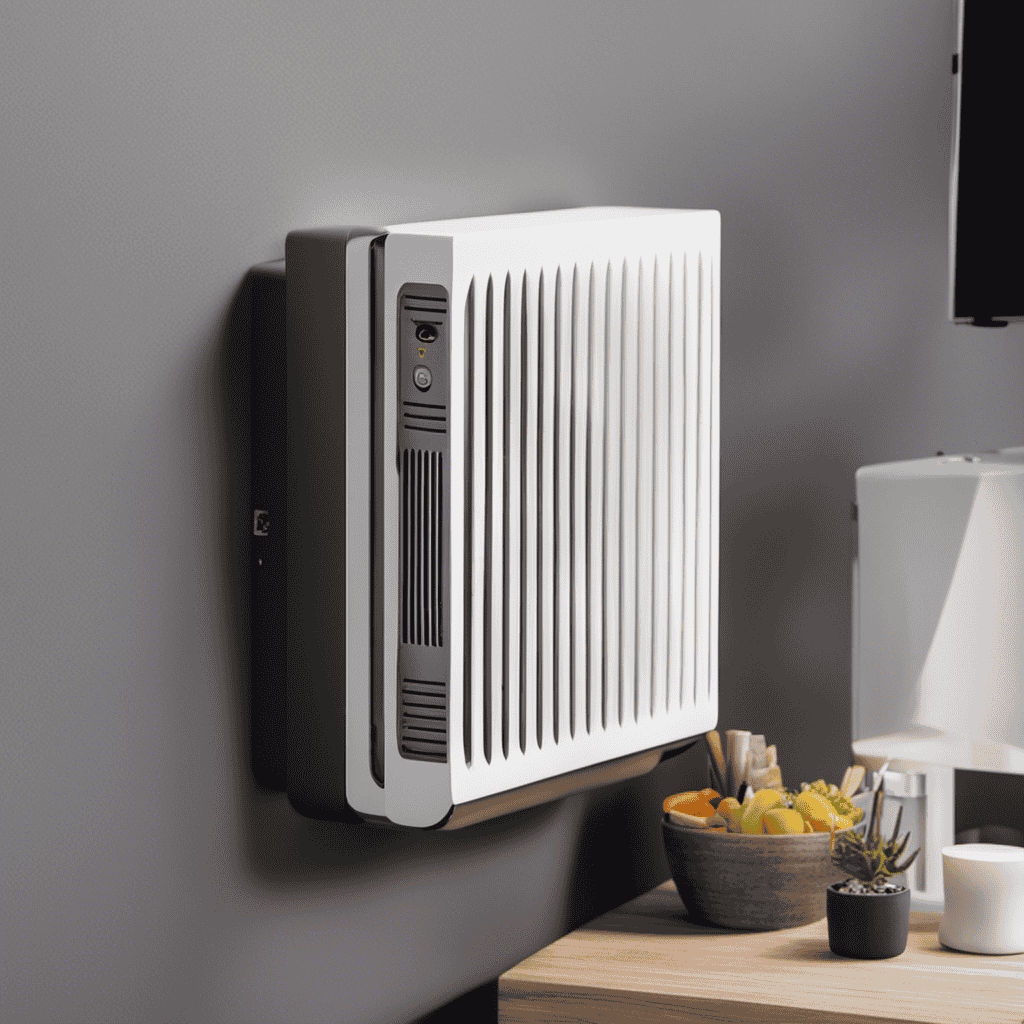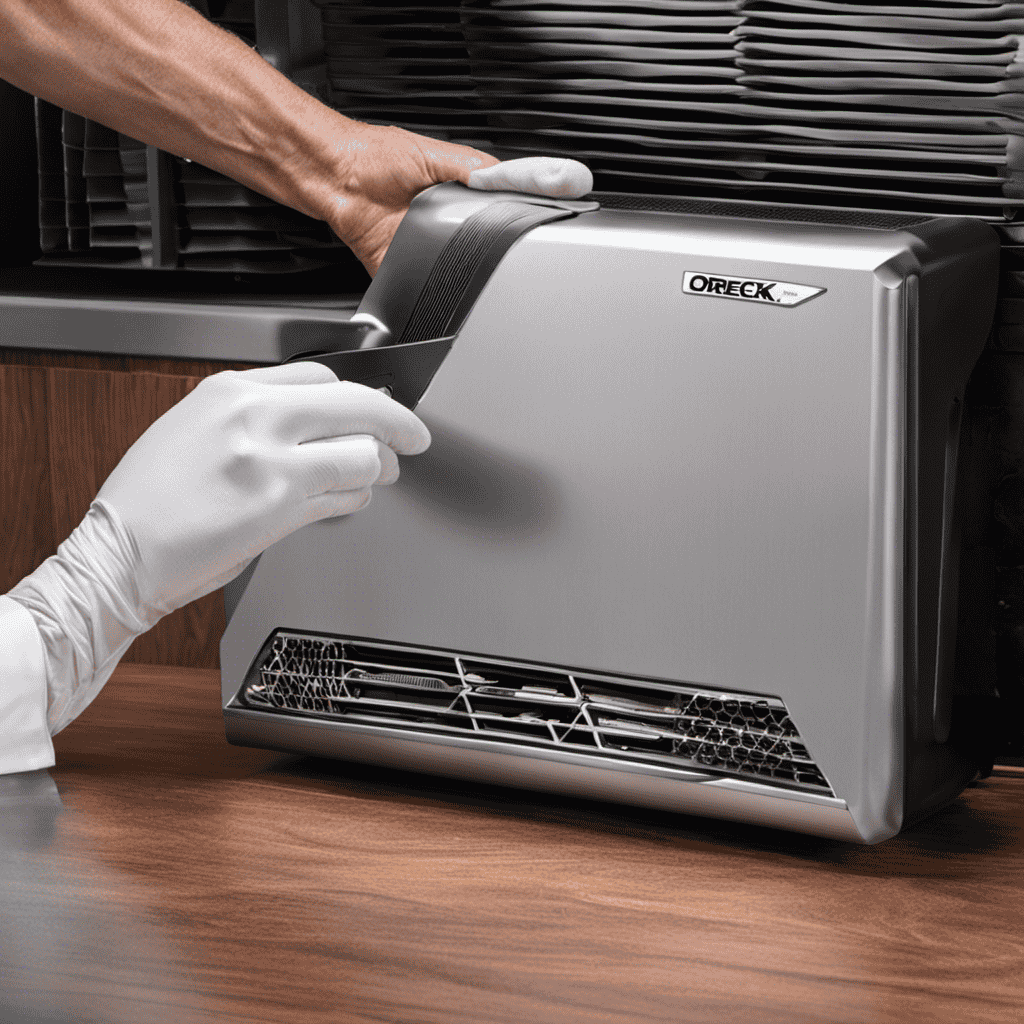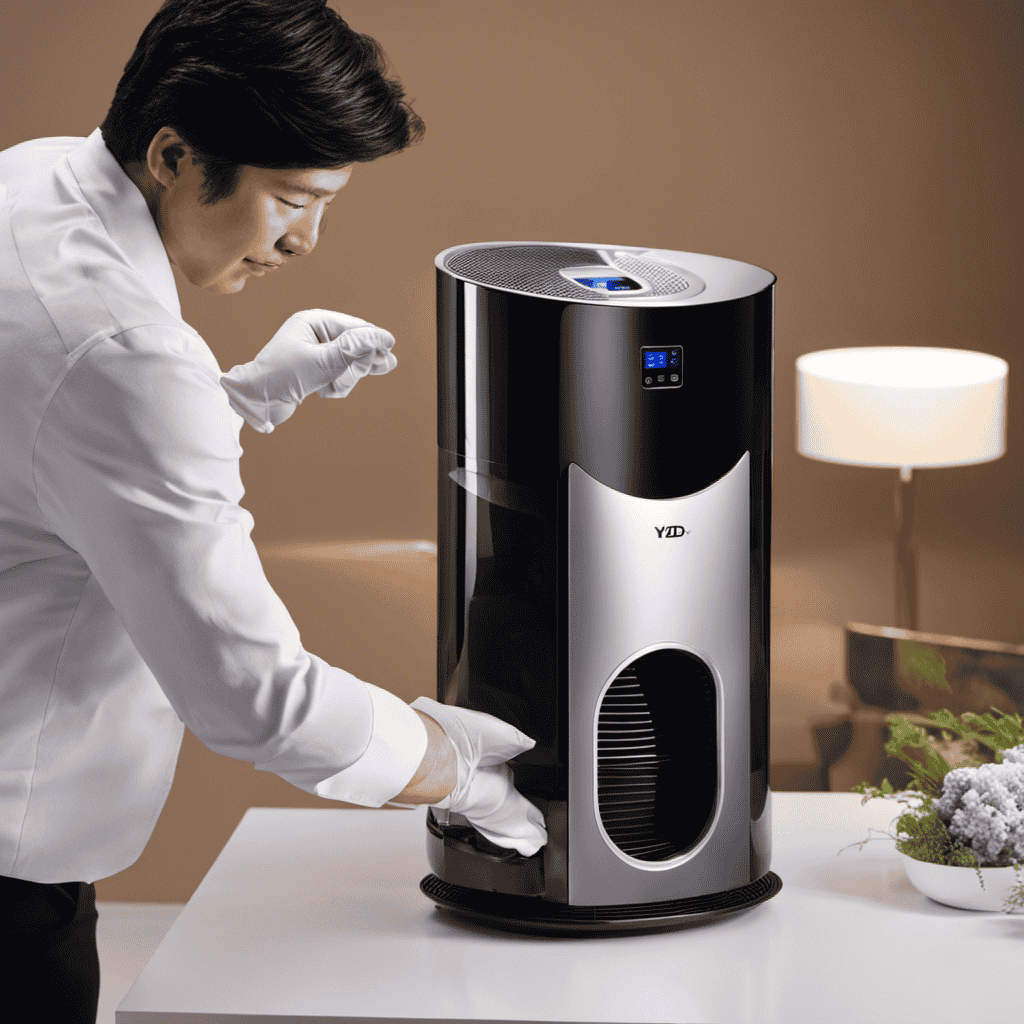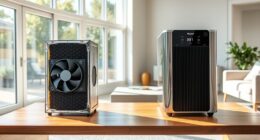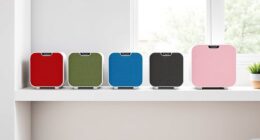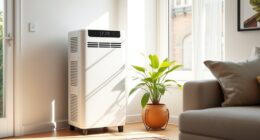To properly dispose of or recycle used air purifier filters, first identify the filter type and follow the manufacturer’s instructions. Turn off and unplug the device before handling, and wear gloves to avoid contact with dust or contaminants. Seal the filter in a plastic bag and check local regulations for disposal or recycling options. Many areas offer special recycling programs or centers—staying informed about these options helps protect the environment. Keep exploring for more tips to manage used filters responsibly.
Key Takeaways
- Check filter material and manufacturer instructions to determine proper disposal or recycling methods.
- Seal filters in plastic bags immediately after removal to prevent dust and pollutant release.
- Follow local regulations and guidelines for disposal, including hazardous waste rules if applicable.
- Explore community recycling programs or facilities that accept air purifier filters for environmentally responsible disposal.
- Consider upcycling or repurposing filters for DIY projects or eco-friendly uses before disposal.
Assessing the Type of Filter You Have
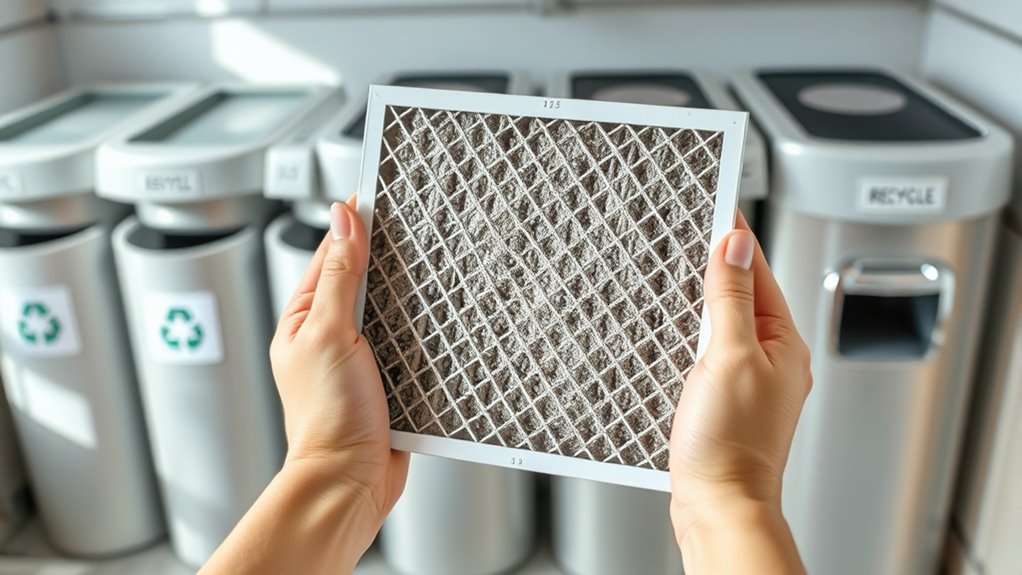
Before deciding how to dispose of your used air purifier filter, you need to identify its type. Check the filter material, as this determines whether it’s a washable, replaceable, or disposable filter. Some filters are made of activated carbon, HEPA fibers, or electrostatic materials. Knowing the filter material helps you understand its environmental impact and disposal options. Also, consider the filter lifespan; most filters have a recommended lifespan, usually between three to twelve months. If your filter has reached or exceeded this period, it’s likely time to replace it. Properly evaluating the type and condition of your filter ensures you handle it correctly, whether that means recycling, disposing of it in the trash, or following specific disposal instructions from the manufacturer. Additionally, understanding the filter materials can help you determine if parts of the filter are recyclable or need special handling. For example, some HEPA filters contain materials that require special disposal procedures to prevent environmental contamination.
Removing and Properly Handling Used Filters
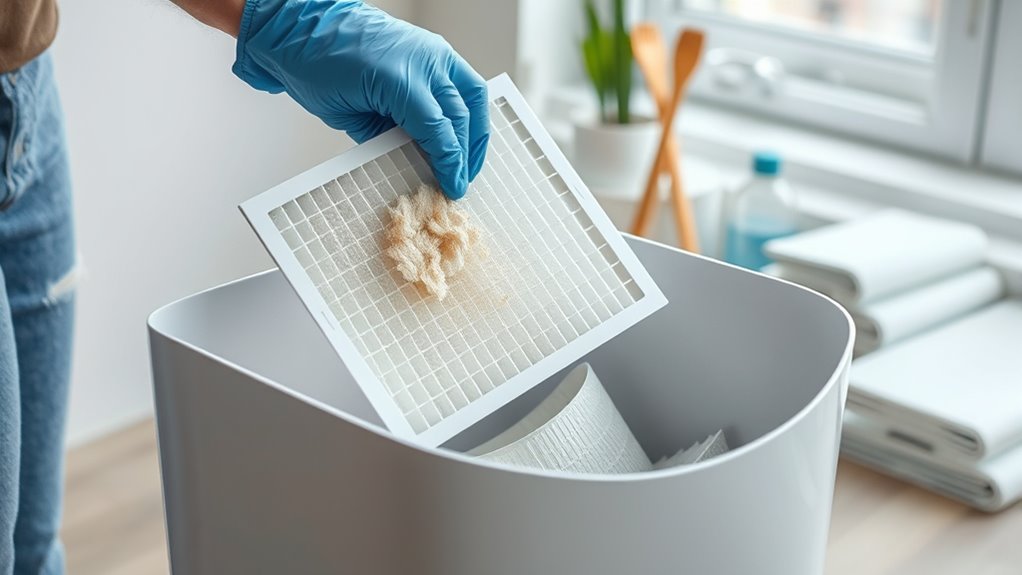
When removing used air purifier filters, make sure to follow safe procedures to avoid spreading dust or contaminants. Handle the filters carefully to prevent exposure to trapped particles, especially if they’ve captured harmful pollutants. Once removed, dispose of them properly according to your local regulations to keep your environment safe. Additionally, consider checking if the filters can be recycled or safely disposed of, to reduce environmental impact. If the filters contain electronic components or batteries, ensure proper disposal methods to prevent environmental harm.
Safe Removal Procedures
To safely remove a used air purifier filter, start by turning off the device and unplugging it to prevent any electrical hazards. Carefully open the unit according to the manufacturer’s instructions. When handling the filter material, wear gloves to avoid direct contact with dust or contaminants. Avoid shaking or dropping the filter, as this can release particles into the air. Check how often you should replace the filter based on the disposal frequency recommended by the manufacturer; overused filters may contain higher concentrations of trapped pollutants. When removing the filter, do so gently and place it in a sealed plastic bag to contain dust. Proper handling minimizes the risk of contaminant dispersal and prepares the filter for safe disposal or recycling. Additionally, understanding data privacy concerns related to air quality data can help ensure responsible information management during the disposal process. Being aware of special occasions can also encourage timely maintenance, preventing the buildup of pollutants. Regularly monitoring air quality data can inform you when it’s time to replace filters to maintain optimal indoor air health. Keeping track of air quality trends can further help in scheduling filter replacements effectively.
Handling Contaminants Carefully
Handling contaminants carefully is essential to prevent releasing trapped pollutants back into the air. When removing used filters, you must be cautious with the filter material to avoid disturbing contaminant types such as dust, pollen, pet dander, mold spores, or airborne bacteria. To minimize risk, follow these precautions:
- Wear gloves and a mask to protect your skin and respiratory system.
- Handle the filter by the edges, avoiding contact with the surface.
- Seal the filter in a plastic bag immediately after removal.
- Store the used filter in a separate, labeled container.
- Avoid shaking or banging the filter to prevent dispersing contaminants.
- Be aware that filters can contain residual pollutants, which should be disposed of or recycled properly to prevent environmental contamination.
- Proper disposal methods can help minimize environmental impact and ensure safety.
- Additionally, consider filter recycling programs to reduce waste and promote sustainability.
- Regularly inspecting and replacing filters as recommended can also help manage contaminant buildup effectively.
- Staying informed about air purifier maintenance best practices can further enhance indoor air quality and safety.
Proper Disposal Methods
After sealing the used filter in a plastic bag and storing it properly, you can proceed with its disposal. Knowing the filter lifespan helps determine when to replace it and how often to dispose of it safely. Typically, filters should be replaced every 3 to 6 months, depending on usage and air quality. Regular disposal reduces the risk of releasing trapped contaminants into your environment. When disposing of the filter, check local regulations—some areas consider used filters household waste, while others require special handling. Always handle the filter carefully to prevent dust or allergens from escaping. Proper disposal methods minimize environmental impact and are essential for maintaining air purifier efficiency. Proper disposal not only ensures your air purifier continues to function effectively but also helps prevent the spread of allergens and pollutants. By following proper disposal methods, you ensure your air purifier remains effective and you minimize environmental impact. Additionally, understanding filter disposal guidelines can help you make environmentally responsible choices. Remember, timely disposal supports cleaner indoor air and responsible waste management.
Understanding Local Disposal Regulations
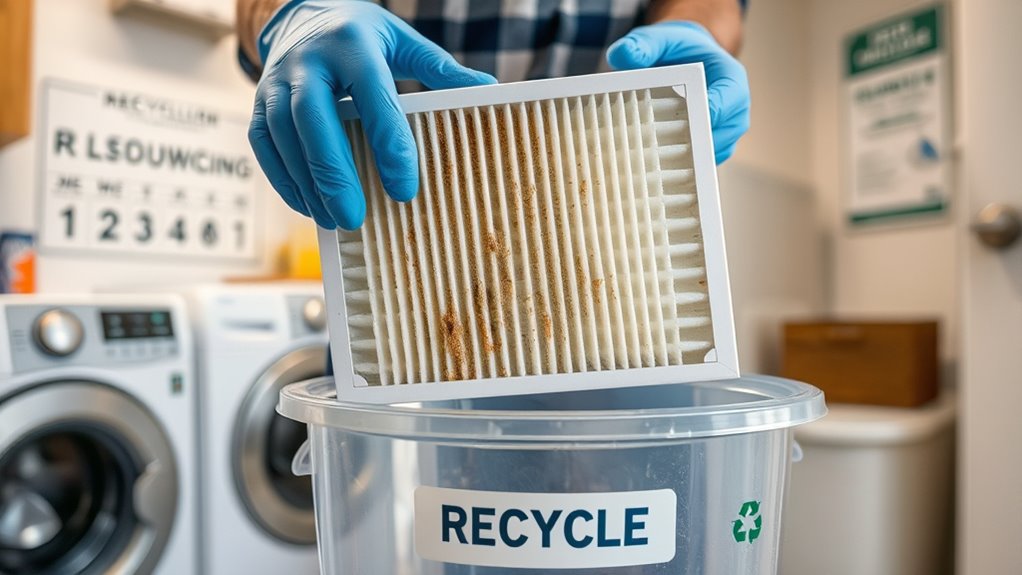
You need to verify your local hazardous waste rules before disposing of your used air purifier filters, as some areas have strict regulations. Recycling options may be available, but not all facilities accept filter materials, so it’s important to find out what’s accessible nearby. Follow any special disposal instructions to ensure you’re handling the filters safely and in compliance with local laws. Additionally, understanding the material composition of the filters can help determine the appropriate disposal method. Being aware of cookie consent and privacy policies can also inform you about how your data might be used if you access online recycling programs or disposal services. Recognizing the sustainable fashion principles can guide environmentally conscious disposal choices that minimize waste. Incorporating remote work best practices can also help reduce unnecessary trips to disposal facilities, contributing further to environmental sustainability. Furthermore, exploring recycling programs specific to filter materials can promote environmentally responsible disposal options.
Local Hazardous Waste Rules
Understanding local hazardous waste rules is essential because disposal regulations for used air purifier filters can vary considerably depending on your area. Proper disposal helps protect air quality and ensures safe filter maintenance. Check your local government’s guidelines to determine if used filters are classified as hazardous waste. Some regions require special handling or drop-off at designated facilities. Others may permit disposal with regular household trash. Always verify if your filters contain hazardous substances like activated carbon or chemical adsorbents. Keep these points in mind:
- Research local hazardous waste collection programs
- Confirm if filters are classified as hazardous materials
- Follow specific packaging instructions
- Schedule proper disposal appointments if needed
- Stay updated on any regulation changes
- Be aware that AI technologies can assist in identifying hazardous substances in used filters through data analysis and testing methods. Understanding local disposal regulations helps ensure compliance and environmental safety. Additionally, staying informed about waste classification can help prevent improper disposal that might harm the environment. Recognizing the types of water contaminants treated by water parks can also guide environmentally responsible disposal practices for other household items. Being aware of recycling options in your community can further reduce waste and promote sustainability.
Recycling Facility Availability
Knowing whether your local recycling facilities accept used air purifier filters is key to proper disposal. Recycling facility availability varies by location, so it’s important to check what types of filter material they handle. Some facilities accept filters made of specific materials like activated carbon or HEPA components, while others do not. Contact your local waste management or recycling center to confirm if they process air purifier filters and learn their guidelines. Keep in mind that even if a facility accepts filter materials, they may require you to separate or prepare the filters in a certain way. Understanding your local disposal regulations assures you don’t accidentally dispose of filters improperly or miss recycling opportunities. Always verify with your local authorities before proceeding to recycle or dispose of used filters.
Special Disposal Instructions
Since disposal regulations vary by location, understanding your area’s specific rules for handling used air purifier filters is vital. Your local guidelines may specify how often you should dispose of filters and what materials are considered hazardous. Check whether the filter material contains harmful substances or requires special handling. Be aware that some regions have strict disposal frequency limits for filters contaminated with allergens or chemicals. To comply, consider these points:
- Confirm if your local waste management accepts filters with specific filter material
- Determine whether disposal must occur at designated facilities
- Follow recommended disposal frequency for your filter type
- Identify if special packaging is required for contaminated filters
- Stay updated on any regulatory changes affecting disposal procedures
- Additionally, understanding the environmental impact of disposal practices helps support sustainable camping and outdoor activities environmental stewardship.
Adhering to these instructions helps ensure safe, legal disposal and environmental protection.
Preparing Filters for Disposal or Recycling
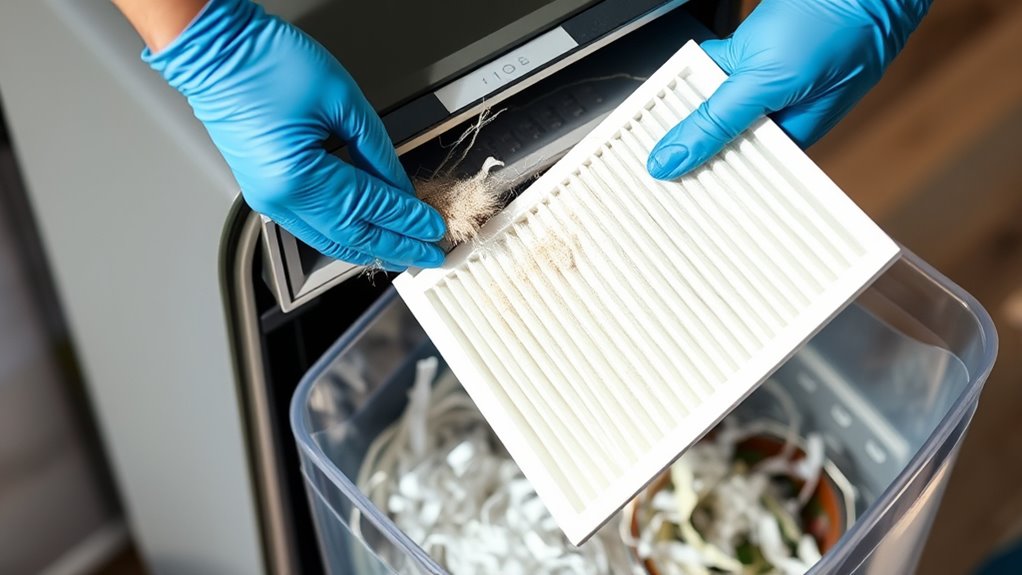
Before disposing of or recycling your used air purifier filters, it’s important to prepare them properly. Start by inspecting the filter for any damage or excessive buildup that could affect air quality. Remove any loose debris or dust using a vacuum or gentle brushing to reduce airborne particles during handling. If the filter is washable and the manufacturer recommends cleaning, do so following their instructions, ensuring it’s completely dry before disposal or recycling. For filters that aren’t washable, carefully fold or seal them in a plastic bag to contain dust and particles. Proper preparation helps maintain filter maintenance standards and prevents contamination. Additionally, understanding the environmental impact of disposal options can guide responsible recycling practices. Taking these steps ensures safer handling and supports efforts to keep indoor air quality high.
Safe Disposal Methods for Used Filters
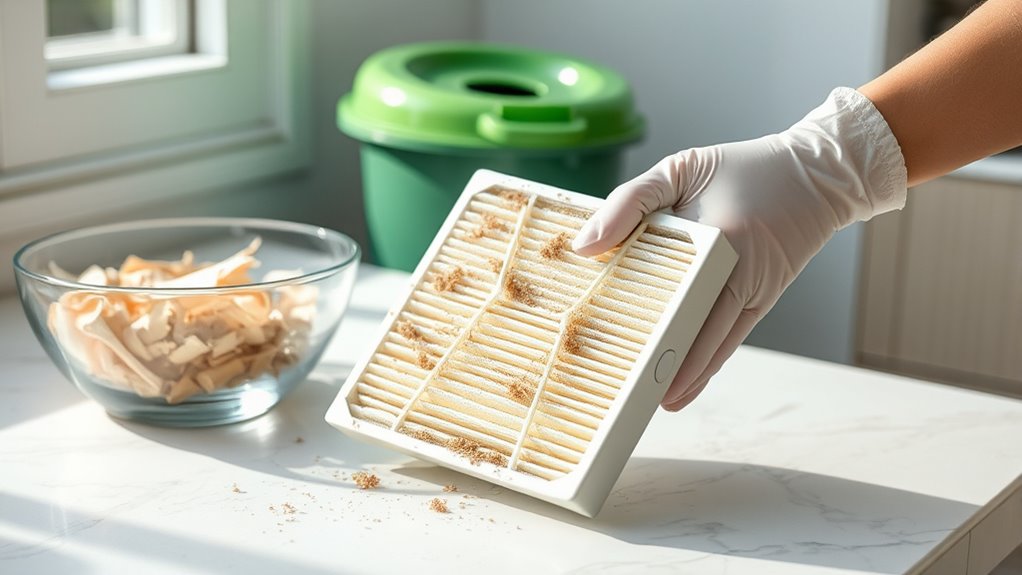
Properly disposing of used air purifier filters helps protect the environment and your health. To guarantee contaminant safety, follow these safe disposal methods:
Proper disposal of used filters safeguards health and the environment effectively.
- Seal filters in a plastic bag before disposal to prevent dust and particles from escaping.
- Contact local waste management for guidance on hazardous waste regulations.
- Avoid crushing or breaking filters to minimize pollutant release.
- Wear gloves and a mask during filter handling to reduce exposure.
- Consider professional disposal services if filters contain high levels of pollutants.
Implementing these practices supports proper filter maintenance and minimizes health risks. Always treat used filters as potentially contaminated, and handle them with care. This approach helps protect both your well-being and the environment while adhering to safety standards.
Recycling Options for Air Purifier Filters
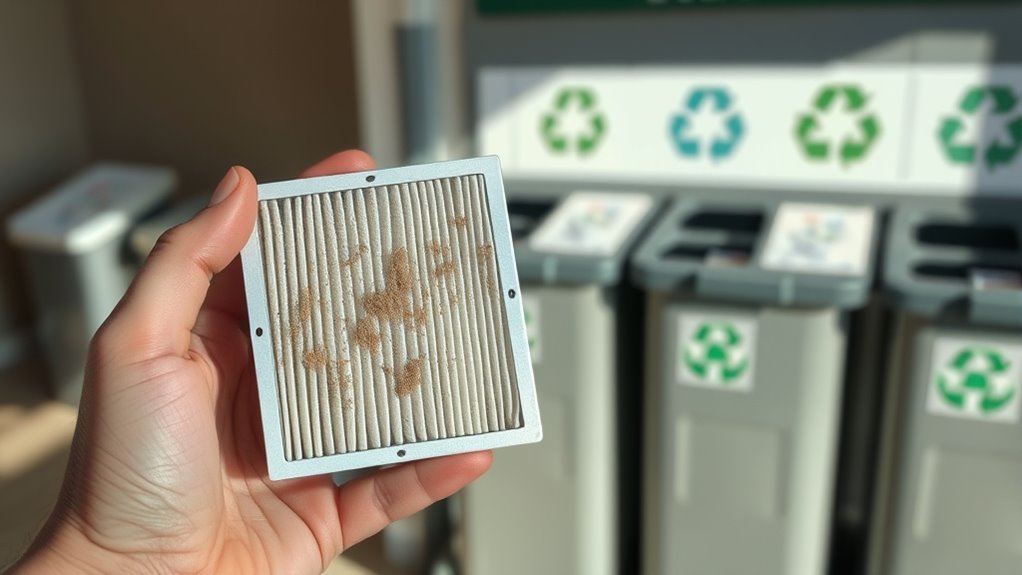
Recycling air purifier filters offers an eco-friendly way to reduce waste and conserve resources. To do this effectively, prioritize filter hygiene and proper filter maintenance. Regularly cleaning or replacing filters as recommended helps keep them in good condition, making recycling easier. Some manufacturers or recycling centers accept used filters for recycling, especially if they’re made from recyclable materials like certain plastics or metals. Always check if your filter can be recycled before disposal. Maintaining the filter’s integrity prevents contamination, making recycling safer and more efficient. Keep your filters clean and follow manufacturer guidelines to maximize their lifespan and recyclability. By choosing recycling options for your air purifier filters, you contribute to reducing landfill waste and supporting sustainable practices.
Finding Recycling Centers or Programs in Your Area
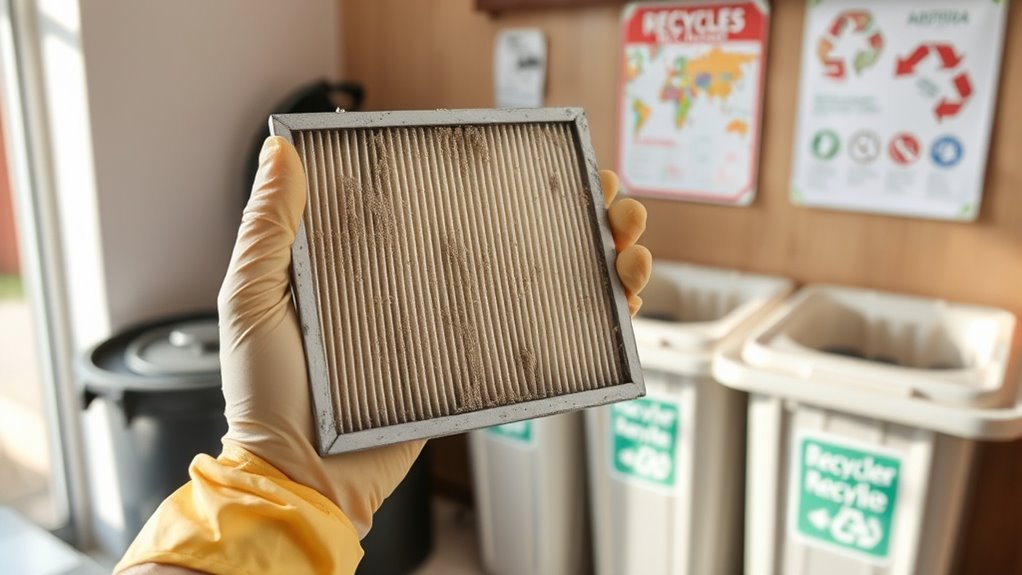
To find recycling centers or programs in your area, start by checking online resources such as local government websites or environmental organization directories. These sources often list facilities accepting specific filter materials and recycling options. You can also contact your city’s waste management department for guidance. Look for programs that specialize in electronic or hazardous waste, as they often process air purifier filters safely. Additionally, consider reaching out to local hardware stores or appliance retailers, as they sometimes partner with recycling centers. Remember to verify whether the program accepts your filter material type and if there are any preparation requirements. By exploring these options, you ensure responsible disposal and support recycling efforts in your community.
Check local government and environmental websites for recycling centers accepting air purifier filters responsibly.
- Local government waste management websites
- Environmental organization directories
- Household hazardous waste collection events
- Retailer recycling programs
- Community recycling centers
Tips for Reducing Waste and Extending Filter Life
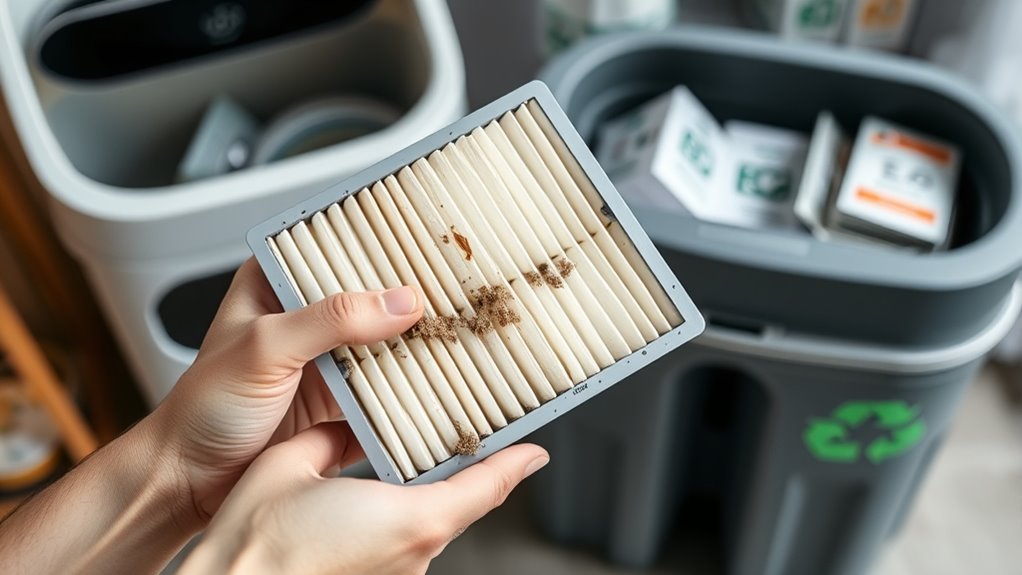
Regularly maintaining and caring for your air purifier filters can substantially reduce waste and help them last longer. Proper filter maintenance ensures maximum air quality and minimizes the frequency of replacements. To extend filter life, check your filters monthly and replace them only when necessary. Keep the surrounding area clean to prevent dust buildup that can clog filters prematurely. Use high-quality filters compatible with your purifier to maximize efficiency and longevity. Consider this comparison:
| Filter Type | Lifespan | Maintenance Tips |
|---|---|---|
| HEPA | 6-12 months | Regularly vacuum or tap to remove dust |
| Activated Carbon | 3-6 months | Replace when odor or pollutants return |
| Pre-filter | 1-3 months | Wash or replace frequently |
| Electrostatic | 1 year | Clean with a damp cloth |
Implementing these tips helps maintain air quality and reduces waste.
Alternative Solutions: Upcycling and Repurposing Filters
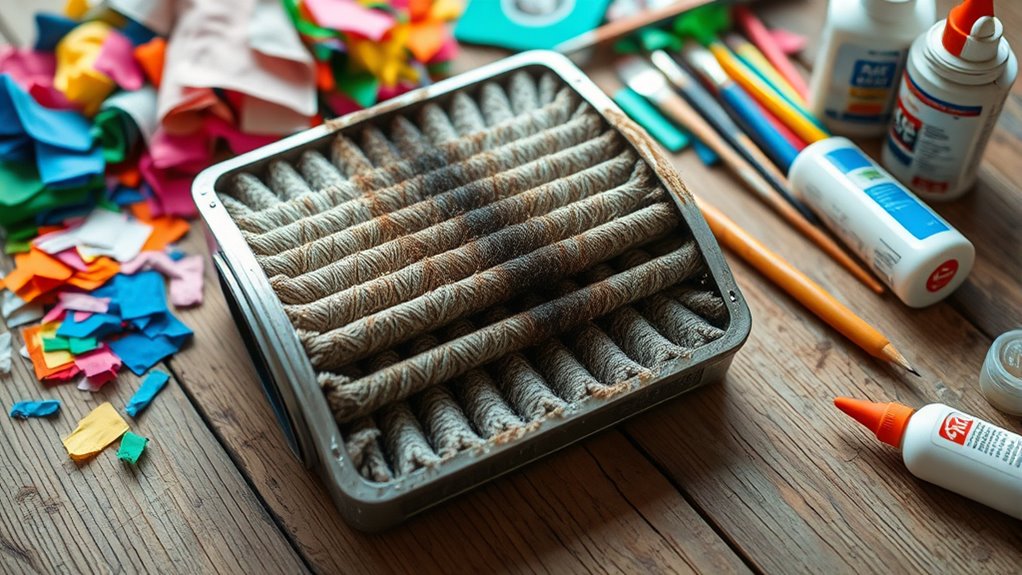
Instead of discarding used air purifier filters after their lifespan ends, consider upcycling or repurposing them for other practical uses. The filter material can be valuable beyond air purification, reducing environmental impact and extending its usefulness. You might:
- Use the filter material as a dust collector for DIY projects
- Repurpose shredded filters as packing material for fragile items
- Transform filters into craft components for art projects
- Incorporate filter material into compost to improve aeration
- Create natural odor absorbers by drying and placing them in small containers
These options not only give your filters a second life but also minimize waste and lessen the environmental impact. By thinking creatively, you turn a consumable item into a sustainable resource, reducing landfill contribution and promoting eco-friendly practices.
Frequently Asked Questions
Are HEPA Filters Hazardous Waste?
You might wonder if HEPA filters are hazardous waste. Generally, they aren’t classified as hazardous waste unless they contain harmful substances or have been contaminated with dangerous materials. Disposal regulations vary by location, so check local guidelines. You should handle used filters carefully, especially if contaminated, and follow proper disposal procedures to prevent environmental harm or health risks. Always consult your local waste management authority for specific disposal instructions.
Can Used Filters Be Safely Composted?
You wonder if used filters can be composted safely. Generally, composting practices aren’t suitable for air purifier filters because they often contain synthetic or non-biodegradable materials that don’t break down naturally. Even if some filters have biodegradable components, it’s best to avoid composting them unless specified by the manufacturer. Proper disposal typically involves recycling or disposing of filters as hazardous waste, following local guidelines for safe handling.
What Are the Costs Associated With Recycling Filters?
Recycling filters is like opening a treasure chest, revealing the costs hidden inside. You’ll need to contemplate filter collection fees and participation in recycling programs, which vary by location. Some programs offer free collection, while others charge a small fee to cover processing costs. By choosing local recycling programs, you can turn waste into worth, keeping your environment clean without breaking the bank.
How Often Should Filters Be Replaced to Reduce Waste?
You should follow your air purifier’s recommended replacement schedule to reduce waste and maximize filter lifespan. Typically, filters need replacing every 3 to 6 months, but this depends on usage and air quality. Sticking to the suggested schedule prevents filter overload and keeps your indoor air clean. Regular replacements also help you avoid unnecessary waste, ensuring you dispose of or recycle used filters responsibly.
Are There Eco-Friendly Alternatives to Traditional Filters?
You might worry eco-friendly filters won’t work well, but many now feature biodegradable materials and hold eco-friendly certifications that guarantee efficiency. These alternatives reduce environmental impact without sacrificing air quality. By choosing filters made from sustainable materials, you help lessen landfill waste and promote greener living. Switching to eco-friendly options is a simple step toward a healthier planet, and many products now meet rigorous standards for performance and sustainability.
Conclusion
Treat your used filters like fragile treasures, carefully handling and disposing of them with care. By understanding your filter type and local rules, you’re guiding them safely to their next chapter—whether recycling or proper disposal. Just as a gardener nurtures their plants, you can extend the life of your filters through mindful use and eco-friendly choices. Together, you’re creating a cleaner, greener world—one filter at a time.



